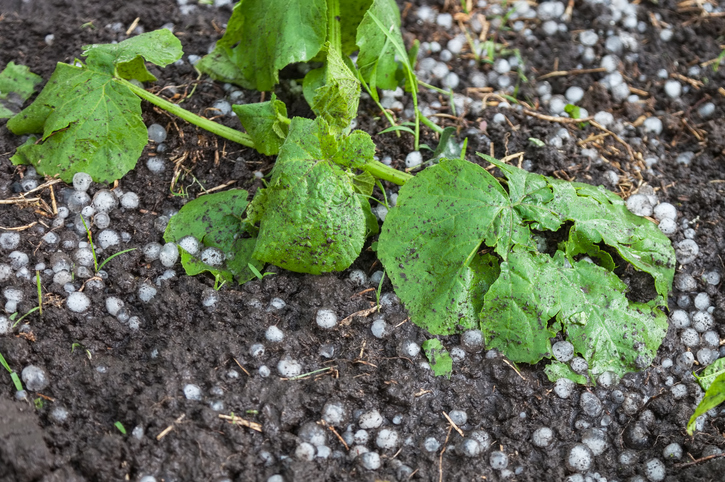Landlocked states see hail more frequently than coastal states, and Arkansas farmers may deal with multiple hail storms each year. Arkansas hail storms can occur in any season and have been reported in all months of the year.
Recent History of Hail in Arkansas
According to Weather.gov, baseball-sized hail was observed in Arkansas from 1980 through 2019 (with an exception of two single years). In that same period, there were over 5,550 accounts of hail the size of a quarter or larger. The largest Arkansas hail on record was five inches in diameter, or a little larger than a CD.
Below are just a few examples of the devastation hail can wreak in our state:
- A June 2009 hail storm damaged 27,000 acres of Arkansas crops, with losses ranging from 10-100 percent of the affected acres.
- An October 2014 hail storm damaged about 24,000 acres of cotton in South Arkansas.
- In July of 2018, U.S. Secretary of Agriculture Sonny Perdue declared Arkansas and Monroe counties natural disaster areas following a wind and hail storm.
- In June 2019, Polk County saw hail that was bigger than a grapefruit.
You can use this interactive hail map to gauge the frequency in your specific area.
Crop Hail Insurance
Farming is an inherently risky business based on many factors that a farmer has no control over. Anyone who makes their living selling crops must have crop insurance. Farm Bureau Insurance offers several crop insurance options that include protection against hail damage.
Crop hail coverage protects against damage from hail and other perils, such as fire, vandalism, theft, and lightning.
Revenue Protection
Revenue protection insurance protects against yield losses caused by natural disasters, including hail and wind. Other covered perils include drought, excessive rain, insects, frost, and disease.
Revenue protection also guards against revenue losses caused by a differentiation between harvest price and projected price. The projected price and the harvest price are determined in accordance with the Commodity Exchange Price Provisions.
Yield Protection
Yield protection insurance covers loss caused by drought, rain, hail, wind, frost, tornado, lightning, flood, insects, disease, temperature extremes, wildlife, and fire. This insurance does not cover adverse pricing events, theft, or vandalism.
Multi-Peril Crop Insurance
Multi-peril crop insurance covers disease, insect infestation, adverse weather events, and loss of revenue due to low production or low market pricing. It also covers an inability to plant due to uncontrollable circumstances, such as frost or excessive moisture.
Do You Need Multi-Peril Crop Insurance or Crop Hail Insurance—or Both?
Multi-peril crop insurance is a federal/private partnership between the Department of Agriculture and providers who sell and service the policies. Farmers may only purchase multi-peril prior to planting. It often has a significant deductible, meaning that farmers must deal with out-of-pocket expenses before the policy kicks in.
Crop hail insurance is a private policy, regulated by the state rather than the Federal Crop Insurance Program. You may purchase crop hail insurance at any time during the growing season (time limits apply on some wind exposure). If a farmer has a particularly strong or valuable crop one year, they can purchase crop hail insurance mid-season. Many farmers in hail-prone states buy crop hail insurance as a supplement to multi-peril crop insurance. Crop hail insurance has little to no deductible, so if part or all of a crop is damaged by hail, the farmer has no out-of-pocket expenses.
Questions About Crop Insurance?
Crop insurance and farm insurance can be confusing. There are many types of policies and specific federal protections in place. The only way to make sure you have the right type and amount of insurance for your farm is to go over your particular risks with a knowledgeable agent. One of our agents at Farm Bureau Insurance would be happy to speak with you today.

